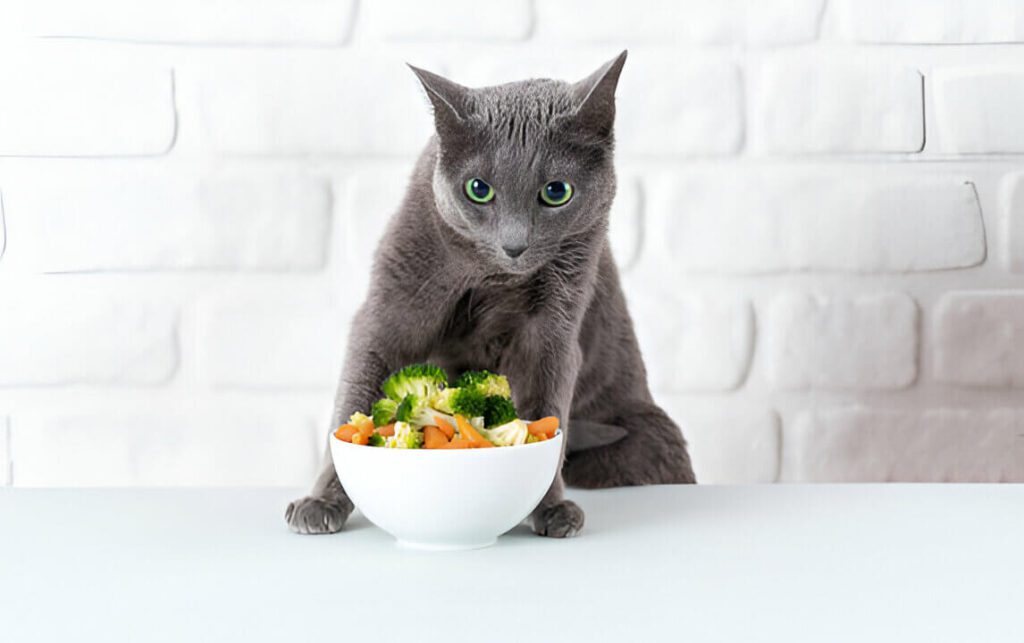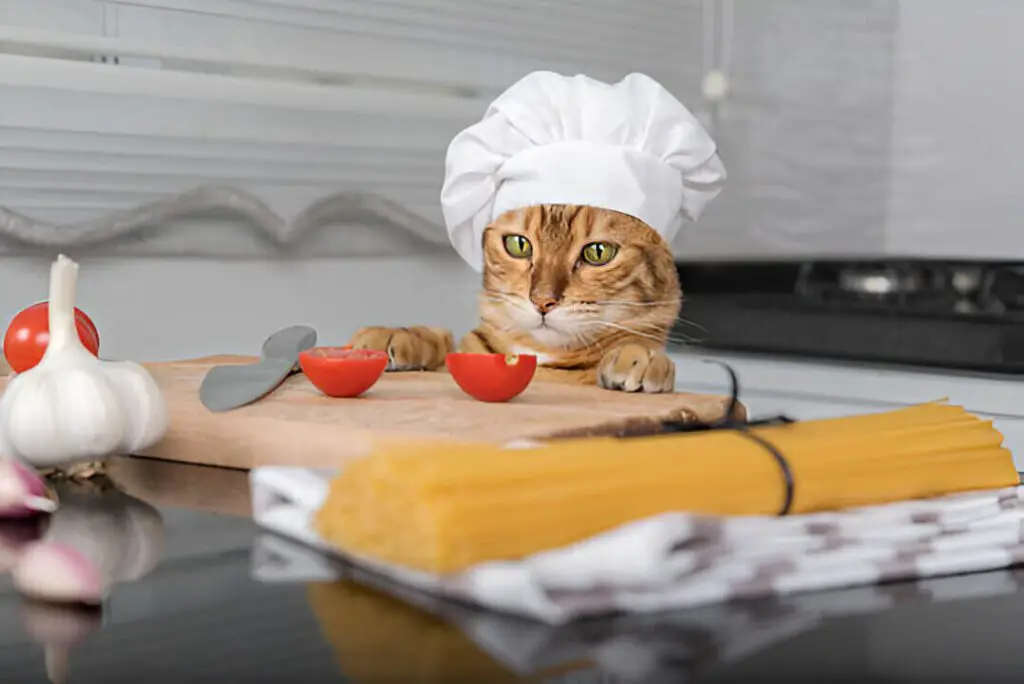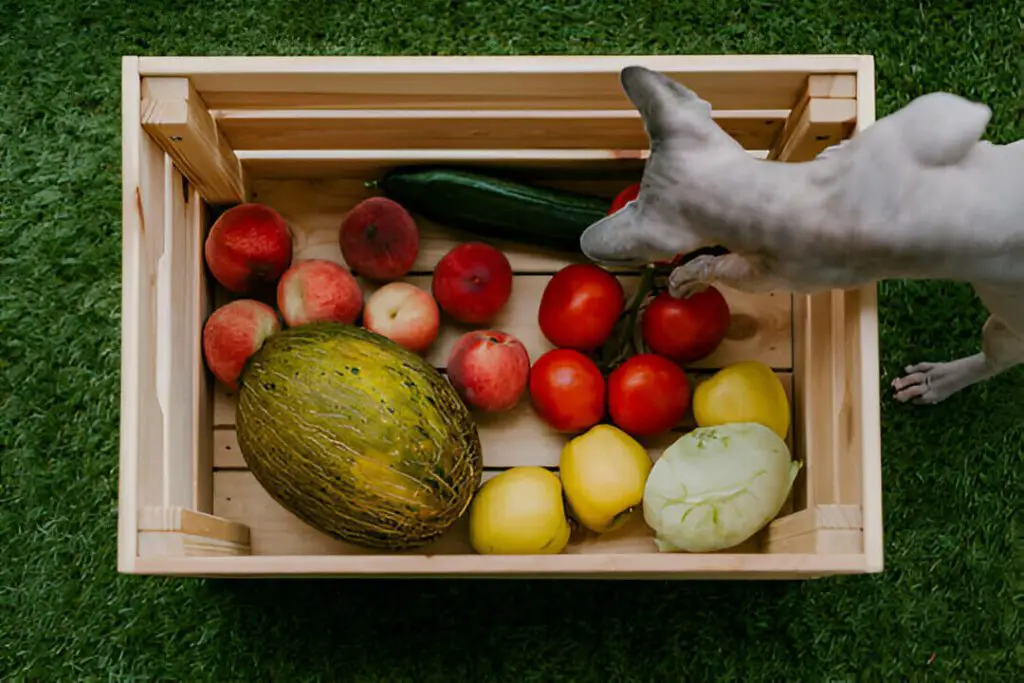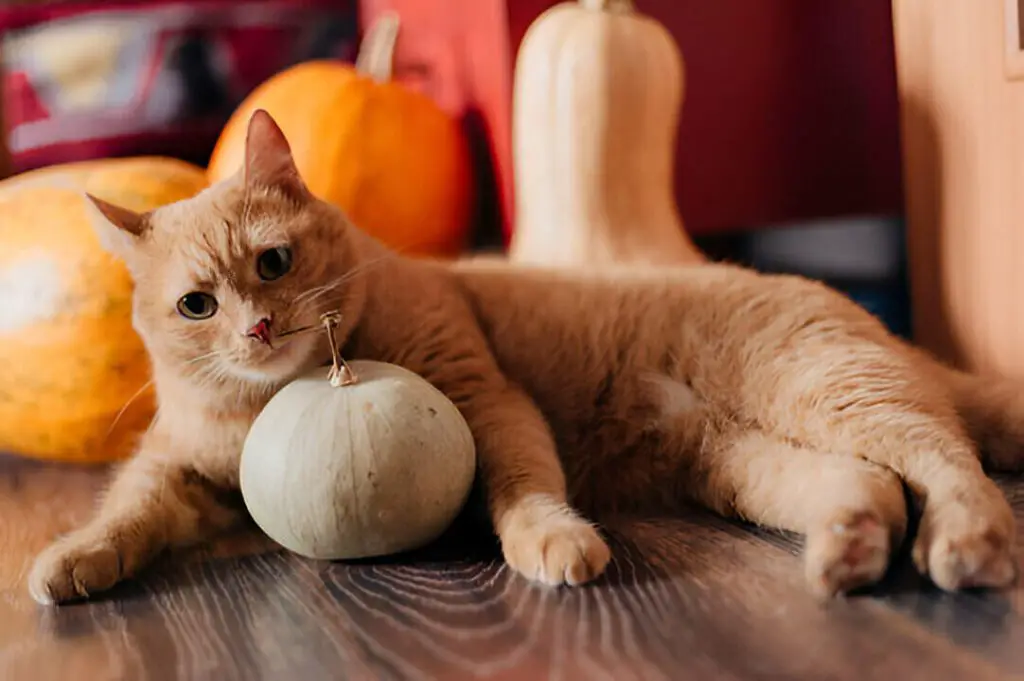Ever looked at your furry friend and wondered, “Can cats eat vegetables?” It’s a question that might pop into your head when your kitty shows interest in that broccoli floret you dropped on the floor. So let’s dive into the world of feline nutrition and get the lowdown on whether vegetables are a yay or nay for our whiskered companions.
Understanding Cats’ Dietary Needs
Before we get to the veggies, it’s crucial to understand that cats are obligate carnivores. This means their bodies are designed to thrive on meat. Their digestive systems are not built to process plant matter efficiently. They get all their essential nutrients from animal proteins and fats. Here’s why:
- Protein Power: Cats need a high amount of protein. It supports muscle development, repair, and energy.
- Taurine Time: Taurine is an amino acid found almost exclusively in animal tissue. It’s vital for a cat’s heart function, vision, and reproduction.
- Fat Facts: Cats use fats as their primary energy source. They also need certain fatty acids that they can only get from meat.
Given this carnivorous nature, vegetables aren’t exactly on a cat’s must-eat list. But does that mean they can’t have them at all? Let’s break it down.
Can Cats Eat Vegetables?

While veggies aren’t necessary for your cat’s diet, some can be safely given as an occasional treat. They might even offer some minor health benefits. Here are a few veggies that can make it to your kitty’s snack list:
Broccoli
Broccoli can be a digestive aid for cats. It helps with bowel movements and can soothe an upset stomach. The key here is to cook the broccoli first. Steaming it lightly and letting it cool ensures it’s soft and retains most of its nutrients. Just don’t overdo it, as too much can lead to diarrhea.
Pumpkin
Pumpkin is a fiber-rich veggie that’s great for cats with constipation or sensitive tummies. Cooked pumpkin (without seeds) can be mixed into their regular food. It helps with digestion and can alleviate mild digestive upsets.
Peas
Peas often find their way into commercial cat foods. They’re safe in small amounts and can aid digestion. Remember to cook the peas first and serve them in moderation. Too many peas can lead to digestive issues like diarrhea.
Cucumber
Cucumbers are hydrating and can be served raw. Remove the skin and wash it thoroughly before offering it to your cat. They’re best given in small slices, occasionally. Overfeeding can result in digestive problems.
Carrot
Cooked carrots are another safe option. Raw carrots pose a choking hazard, so always boil or steam them until soft. Once cooled, they can be added to your cat’s meal. Carrots are rich in vitamins but should only be given sparingly.
Asparagus
Asparagus can be a fun treat,but itt needs to be cooked to avoid choking. It’s high in fiber, so give it in small amounts. Too much can cause gastrointestinal issues and affect urinary health due to its high alkaline content.
Zucchini
Zucchini is low in calories and high in water, making it a non-threatening veggie. Cook it before serving and offer it occasionally. It’s not a nutritional powerhouse for cats but is safe.
Lettuce
Lettuce is mostly water and fiber. It can help with digestion if given in tiny amounts. Chop it into small pieces to avoid choking hazards. Different types like iceberg, leaf, or romaine are all safe, but stick to small servings.
Vegetables to Avoid

Some vegetables are a no-go for cats due to their toxic properties. Even a small amount can be harmful. Here’s a list of veggies that should never be on your cat’s menu:
Garlic
Garlic is highly toxic to cats. It can cause severe gastrointestinal upset and damage red blood cells, leading to anemia. Even a small clove can be dangerous, so keep garlic away from your kitty.
Onions
Onions, in any form—raw, cooked, or powdered—are poisonous to cats. They cause the destruction of red blood cells, which can lead to anemia and other serious health issues. Symptoms of onion poisoning include vomiting, diarrhea, lethargy, and anemia.
Tomatoes
Tomatoes contain solanine, a toxin harmful to cats. Both the green parts and the ripe fruit are dangerous. Symptoms of tomato poisoning include vomiting, diarrhea, and lethargy. Avoid giving your cat tomatoes or any products containing them.
Can Cats Eat Fruits?

You might wonder, if some veggies are okay, what about fruits? Cats can eat certain fruits in moderation. Here’s a quick list of safe fruits:
- Strawberries: Remove stems and leaves.
- Bananas: Small slices are fine.
- Apples: Remove seeds and stems.
- Seedless Watermelon: Small cubes are safe.
- Berries: Blueberries, raspberries, and blackberries are okay.
- Mango: Only the flesh, no skin or seeds.
- Pineapple: Fresh only, no canned.
- Cantaloupe: Many cats love the smell, small pieces are safe.
However, some fruits should be avoided:
- Grapes and Raisins: Can cause kidney failure.
- Citrus Fruits: Oranges, lemons, and limes can cause digestive issues.
Ideal Cat Diet
A cat’s diet should be balanced and primarily composed of animal proteins. Here’s a quick snapshot of what makes a perfect cat diet:
- Protein: Over 50% of their diet. Essential for muscle, energy, and overall health.
- Fat: Up to 20%. Provides energy and supports cell function.
- Carbs: Less than 3%. Cats have no nutritional requirement for carbohydrates.
Most high-quality commercial cat foods are formulated to meet these nutritional needs. Wet food closely resembles a cat’s natural diet and is often preferable over dry food, which can be high in carbs and may lead to obesity and diabetes.
Mixing It Up
While dry food can help with dental health, it’s often a good idea to combine it with wet food to ensure your cat stays hydrated and healthy. Here are a few tips:
- Wet Food: Offers hydration and mimics a natural diet.
- Dry Food: Can help with dental hygiene but should not be the main food source.
- Balanced Treats: Include occasional treats like cooked meat or safe vegetables.
Best Treats for Cats
Cats are meat lovers, so meat-based treats are always a hit. Here are some options:
- Poultry and Fish: Chicken, turkey, tuna, salmon, sardines, and prawns are all great.
- Organ Meats: Liver can be given sparingly.
- Deli Meats: Ham and bacon are tasty but should be given in moderation due to high sodium content.
Avoid giving raw meat unless you follow strict sanitary protocols to prevent bacterial infections.
Why Not a Vegan Cat?
You might wonder, with all this talk about veggies, can cats be vegan? The short answer is no. Cats need specific nutrients found only in animal products. Here’s why:
- Taurine: Essential for heart and eye health, only found in meat.
- Vitamin A: Cats can’t convert beta-carotene to vitamin A; they need it from animal sources.
- Arachidonic Acid: An essential fatty acid that cats must get from animal fats.
A vegan diet can lead to severe health issues and deficiencies. Always prioritize your cat’s health by ensuring their diet is rich in the nutrients they need.
What if My Cat Refuses Vegetables?
It’s entirely normal! As obligate carnivores, cats have taste buds that lean heavily towards meaty goodness. They might give you that judging stare as if to say, “Human, what are you thinking?”
But hey, every cat is unique, just like every hooman! If your feline companion refuses to embrace the veggie lifestyle, that’s completely okay. As long as they’re consuming a well-balanced diet that meets their nutritional needs, they’ll be one happy and healthy ball of fur!
How to Feed Vegetables to Your Cat
When feeding vegetables to your cat, it is important to start slowly and introduce them one at a time. This will help you determine if your cat is allergic to any particular vegetable. You should also cook vegetables before giving them to your cat, as raw vegetables can be hard to digest.
Here are some additional tips for feeding vegetables to your cat:
- Cut vegetables into small pieces that are easy for your cat to eat.
- Steam or roast vegetables to make them more palatable.
- Mix vegetables with your cat’s regular food.
- Offer vegetables as a snack or treat.
With a little care and attention, you can help your cat enjoy a healthy and balanced diet that includes vegetables.
How Much Vegetables Should Cats Eat?

The amount of vegetables that you should feed your cat depends on their individual needs. However, as a general rule, you should aim to feed your cat no more than 10% of their daily food intake in vegetables.
Other Things to Keep in Mind
- When feeding vegetables to your cat, it is important to avoid giving them any vegetables that are high in sugar or fat.
- The type of vegetable that you choose should be appropriate for your cat’s age and health.
- If your cat is not used to eating vegetables, start by offering them a small amount and gradually increase the amount over time.
- Be sure to wash vegetables thoroughly before giving them to your cat.
- Do not overfeed your cat vegetables, as this can lead to weight gain.
- If you are unsure about whether a particular vegetable is safe for your cat to eat, it is best to consult with your veterinarian.
With a little planning, you can easily incorporate vegetables into your cat’s diet and help them stay healthy and happy.
FAQs
Why do cats eat grass?
Cats eat grass to help them cough up hairballs and aid their digestion. In the wild, they consume the entire prey, including fur and bones, which naturally provides essential fibers. Grass nibbling replicates this behavior and helps them maintain a healthy digestive system.
Can cats eat avocado?
No, avocados contain a substance called persin that is not safe for cats. It’s best to avoid offering avocados to our feline friends.
Can I feed my cat homemade meals with vegetables?
While it’s possible to prepare homemade meals for cats, it’s essential to ensure they meet their nutritional needs. If you plan to include vegetables, be sure they are cat-safe and prepared appropriately. Consult your vet to create a balanced diet for your feline friend.
Why do cats sometimes eat non-food items like plants or plastic?
Cats might eat non-food items like plants or plastic due to various reasons, including boredom, curiosity, or seeking attention. For some cats, chewing on non-food items is a way to alleviate stress or anxiety. However, this behavior, known as “pica,” can be dangerous and lead to intestinal blockages. If you notice your cat consuming non-food items excessively, consult your veterinarian to rule out any underlying health issues and address the behavior.
Can I feed my cat a vegetarian or vegan diet?
As obligate carnivores, cats have specific dietary requirements that can be challenging to meet with a vegetarian or vegan diet. While some pet owners might choose these diets for ethical reasons, it’s crucial to recognize that cats need essential nutrients like taurine and arachidonic acid found predominantly in animal-based proteins. Feeding a vegetarian or vegan diet to a cat requires careful consideration and must be done under the guidance of a veterinarian to avoid nutritional deficiencies.
Are there any vegetables that can help with my cat’s weight management?
Yes, certain vegetables can be included in a weight management plan for cats. Low-calorie and high-fiber veggies like steamed broccoli or cooked carrots can be given as occasional treats. They help promote a feeling of fullness without adding many calories. However, remember that weight management in cats should be done under the guidance of a veterinarian to ensure a balanced and healthy diet.
How can I tell if my cat has digestive issues related to vegetable consumption?
If your cat experiences digestive issues related to vegetable consumption, you may notice symptoms such as vomiting, diarrhea, or changes in bowel movements. These signs could indicate that a particular vegetable doesn’t agree with your cat’s digestive system. If you observe such issues, refrain from offering that vegetable and consult your veterinarian for advice.
Is it okay to mix vegetables with commercial cat food?
Mixing small amounts of cat-safe vegetables with your cat’s regular commercial food can be a fun way to add variety and enrichment to their diet. However, the primary source of nutrition should come from the cat food to ensure they receive all essential nutrients. Moderation is key, and if you’re unsure about specific vegetables, consult your vet.
How can I encourage my cat to eat vegetables if they show no interest?
It’s essential to respect your cat’s natural preferences and not force them to eat vegetables. However, you can try offering cooked vegetables as an occasional treat to see if they show any interest. Make sure the pieces are small and easy to chew. If your cat refuses, don’t worry—focus on providing a balanced diet with high-quality cat food.
Can kittens eat vegetables, or is it only for adult cats?
Kittens have specific dietary requirements for their rapid growth and development. While it’s best to prioritize high-quality kitten food that meets their needs, some vegetables in small amounts might be safe for kittens as well. Consult your veterinarian before introducing any new foods into a kitten’s diet.
Are there any alternatives to vegetables for promoting good digestion in cats?
If your cat isn’t interested in veggies, there are other ways to promote good digestion. Providing access to fresh water at all times is crucial. Additionally, consider offering commercial cat foods designed to support digestion or including specific supplements recommended by your veterinarian.
Conclusion
So, can cats eat vegetables? The answer is yes, but with caution and moderation. While veggies aren’t necessary for their diet, some can offer minor health benefits and serve as occasional treats. Always ensure the vegetables are safe, properly prepared, and given in small amounts.
Remember, your cat’s diet should be primarily composed of high-quality animal proteins. Treat vegetables and fruits as supplementary snacks rather than dietary staples. And always consult with your vet before making significant changes to your cat’s diet.
By understanding your cat’s nutritional needs and carefully selecting their treats, you can keep your feline friend happy, healthy, and purring with delight. So, the next time your kitty eyes that piece of cucumber, you’ll know exactly what to do. Happy feeding, cat lovers!


